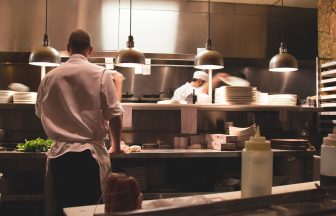The Ultimate Japanese Knife
Highly versatile and extremely easy to use, the nakiri is a cleaver-looking knife which is extremely popular in Japan. The word “nakiri” translates to “leaf cutter” is designed for cutting vegetables. Nakiri blades are similar to a chef’s knife – they’re tall, extremely thin, and feature a flat edge which means the whole blade makes contact with the cutting board without needing to follow through. This prevents your knuckles from hitting the cutting board with each chop. With just a few minutes of practice, anyone can become comfortable with using this vegetable knife. In today’s article, we’ll learn more about using a nakiri.
Nakiri’s are double-beveled vegetable knives. Like most North American or European kitchen knives, nakiri’s are ground and sharpened symmetrically. This makes nakiri knives easy to use and sharpen when compared to single-beveled knives.
The King of Paper-Thin Slices
The usuba knives, similar to nakiri’s, is another type of traditional Japanese vegetable knife. The word “usuba” translates to “thin blade”, and it’s the knives’ thin edges that make them so special. Usuba’s are only ground and sharpened on one side, meaning they’re single-beveled knives. One major difference between usuba and nakiri knives is that usuba knives are much harder to sharpen. Usuba knives are also meant for professional use, as these knives are heavier, sharper and longer, making them best suited for oft-used cutting technique. In fact, usuba knives are usually the first knives Japanese trainee chefs must master, a process that can take years.
Once mastered, Japanese chefs often favor using usuba knives due to its incredible performance and ability to perform difficult cuts. The edges are extremely sharp, which makes usuba’s the perfect choice for cutting and slicing material into very thin pieces with great precision. However, due to the fineness of an usuba blade, you’ll need to avoid using it to slice harder veggies such as Kabocha squash, as harder and thinner steel can become easily dull or chipped by hard foods. Chefs who like to perform rotary peeling also like using usuba knives.
Due to its thicker spine, usuba knives are going to be heavier than nakiri’s. If you plan on sharpening an usuba, be very careful and make sure you know the correct sharpening process as single-beveled knives require more care and expertise when sharpening as opposed to double-beveled knives. While usuba knives require more whetstone work, the end result if done correctly is marvelous!
Should I get a Nakiri or Usuba?
This depends on what type of cutting you’re looking for and your expertise level. Nakiri knives are easy to use, and for beginners, it’s easy to get the most out of them. If you’re a casual cook who wants a well-designed utensil that can manage all types of vegetables, then nakiri is the knife for you. On the other hand, if you’re looking for a knife with a more refined edge that can be used to for decorative carving or making paper-thin slices, then the usuba is the knife you’re looking for. Simply put, if you want to mince a big pile cilantro or green onions, then use a nakiri. If you’re looking to make ultra-thin onion slices, then use an usuba.
Key Differences Between a Nakiri and Usuba
Nakiri
| Blade | Double-beveled blade |
|---|---|
| Strengths | a great everyday knife with a strong edge |
| Usability | Suitable for both left and right-handed users |
| Sharpening Difficulty | Average |
Usuba
| Blade | Single-beveled blade |
|---|---|
| Strengths | a great blade with a delicate edge for performing delicate cuts |
| Usability | there are models specifically created for left or right-handed users |
| Sharpening Difficulty | High, experience required |











